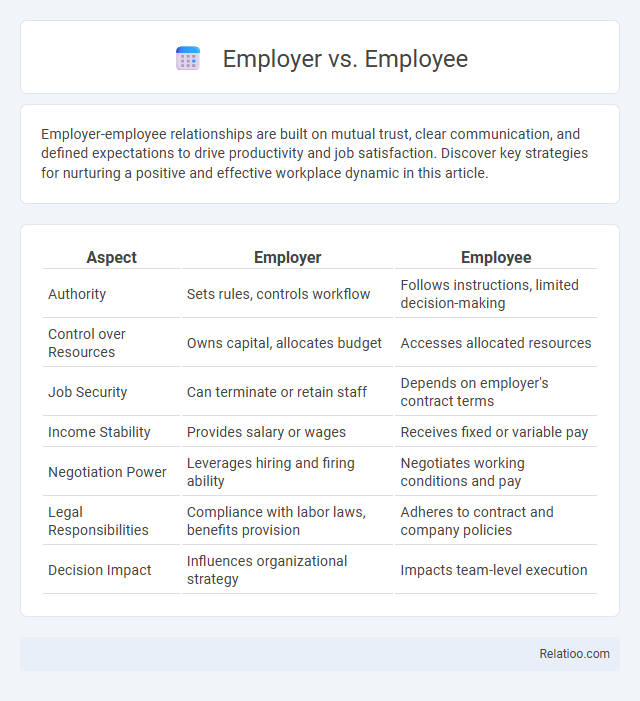Employer-employee relationships are built on mutual trust, clear communication, and defined expectations to drive productivity and job satisfaction. Discover key strategies for nurturing a positive and effective workplace dynamic in this article.
Table of Comparison
| Aspect | Employer | Employee |
|---|---|---|
| Authority | Sets rules, controls workflow | Follows instructions, limited decision-making |
| Control over Resources | Owns capital, allocates budget | Accesses allocated resources |
| Job Security | Can terminate or retain staff | Depends on employer's contract terms |
| Income Stability | Provides salary or wages | Receives fixed or variable pay |
| Negotiation Power | Leverages hiring and firing ability | Negotiates working conditions and pay |
| Legal Responsibilities | Compliance with labor laws, benefits provision | Adheres to contract and company policies |
| Decision Impact | Influences organizational strategy | Impacts team-level execution |
Understanding the Employer-Employee Relationship
The employer-employee relationship is characterized by a contractual agreement where employers provide compensation and work conditions while employees deliver labor and services. Disparity often arises due to imbalances in power, wage gaps, and differing access to benefits, impacting job satisfaction and productivity. Understanding these dynamics helps organizations foster equity, enhance communication, and reduce conflict within the workplace.
Key Roles and Responsibilities
Employers are responsible for providing job opportunities, ensuring workplace safety, and managing organizational goals, while employees focus on executing tasks, adhering to company policies, and contributing to productivity. Disparity arises when there is an imbalance in power, compensation, or access to resources between employers and employees, affecting workplace morale and efficiency. Understanding these key roles and responsibilities helps you navigate professional relationships and address inequalities effectively.
Legal Rights and Obligations
Employers hold legal obligations to provide a safe working environment, adhere to labor laws, and ensure timely payment of wages, while employees have rights to fair compensation, non-discrimination, and freedom from unlawful termination. Disparity often arises when these rights and obligations are not equally enforced or respected, leading to conflicts such as wage theft, workplace harassment, or inequitable treatment. Legal frameworks like the Fair Labor Standards Act (FLSA) and Equal Employment Opportunity Commission (EEOC) regulations serve to balance these interests and mitigate disparity between employers and employees.
Power Dynamics in the Workplace
Power dynamics in the workplace often create a significant disparity between employer and employee roles, where employers hold decision-making authority, control over resources, and influence on career advancement. Your ability to navigate these imbalances can impact job satisfaction, negotiation outcomes, and workplace equity, highlighting the importance of awareness and communication. Understanding how power is distributed helps in fostering a more balanced work environment and promoting fair treatment.
Decision-Making Authority
Employer holds primary decision-making authority within organizational structures, controlling strategic directions, resource allocations, and policy implementations. Employees possess limited decision-making power, often confined to task execution and immediate operational choices under employer guidelines. The disparity in decision-making authority generates hierarchical dynamics impacting workplace autonomy, responsibility distribution, and organizational efficiency.
Compensation and Benefits Differences
Compensation and benefits disparities between employers and employees frequently stem from differences in salary structures, bonus eligibility, and access to health insurance or retirement plans. Employers typically design compensation packages based on organizational roles, industry standards, and financial performance, while employees often experience variations due to job level, tenure, and negotiation capabilities. These disparities impact employee satisfaction, retention rates, and overall workforce productivity across diverse sectors.
Career Growth Opportunities
Employers often control career growth opportunities by designing promotion pathways and skill development programs, which directly impact employee advancement and satisfaction. Employees seek clear, fair criteria for progression to reduce disparity and ensure equitable access to training, mentorship, and leadership roles. Disparity in career growth arises when systemic biases or unequal resource allocation limit certain groups from achieving their full potential within an organization.
Conflict Resolution and Communication
Effective conflict resolution and clear communication are essential in bridging the disparity between employer and employee interests. You can foster mutual understanding by implementing transparent dialogue channels and addressing concerns promptly to prevent misunderstandings and build trust. Prioritizing empathy and active listening helps resolve conflicts constructively, promoting a harmonious workplace environment.
Work-Life Balance: Employer vs Employee Perspectives
Employers often emphasize productivity and business outcomes when evaluating work-life balance, prioritizing structured schedules and measurable results to meet organizational goals. Employees, on the other hand, value flexibility and time for personal well-being, seeking arrangements that reduce stress and enhance overall satisfaction. Understanding these perspectives helps you bridge the disparity and create policies that support both business performance and employee wellness.
Adapting to Changing Work Environments
Employers and employees face significant disparity in adapting to changing work environments, with employers prioritizing strategic shifts and technology integration while employees often focus on skill development and job security. Your ability to navigate this disparity is crucial for maintaining productivity and fostering collaboration as both parties adjust to new workflows and remote work dynamics. Understanding these evolving roles helps bridge gaps and create a more resilient workplace culture.

Infographic: Employer vs Employee
 relatioo.com
relatioo.com